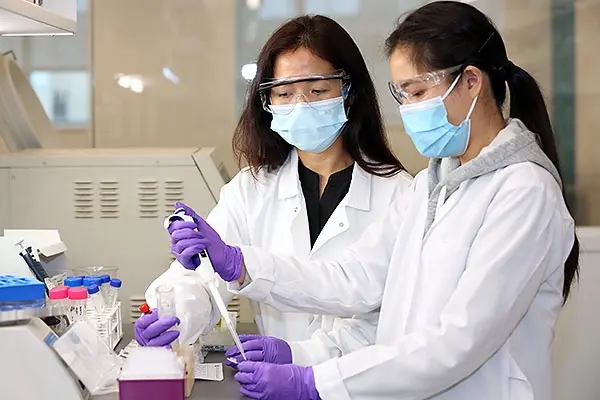“DiSenDa” Project Wins $660,000 Prize in Global Trinity Challenge Competition
 Image by National Institute of Allergy and Infectious Diseases, NIH
Image by National Institute of Allergy and Infectious Diseases, NIH
This colorized, highly magnified view of a cluster of SARS-CoV-2 particles was captured with a transmission electron microscope. It shows the surface spike proteins that the virus uses to penetrate and infect healthy host cells.
08/05/2021
By Edwin L. Aguirre
A team of researchers from UMass Lowell and Northeastern University is creating and testing a low-cost, automated wireless sensor network that could detect SARS-CoV-2, the virus that causes COVID-19, in the air and in wastewater in real time, and predict potential outbreaks before they occur.
Asst. Prof. Sheree Pagsuyoin of UML’s Department of Civil and Environmental Engineering is leading the project, called “DiSenDa,” which stands for Disease Surveillance with Multi-Modal Sensor Network and Data Analytics.
“Our goal is to track COVID-19 transmission and prevent outbreaks before they spiral out of control and cost people’s lives and livelihoods,” she says. “The probes attached to the sensors have been specifically designed to detect the presence of biomarkers for SARS-CoV-2 in the air and in wastewater samples.”
According to Pagsuyoin, this is the first time that cutting-edge technologies such as wireless sensing, genomic testing, cloud computing, real-time data analytics, artificial intelligence/machine learning and mobile apps are being used together to fight the pandemic.
“Our three-year pilot study will target COVID-19 first, but ultimately, we hope to use the same technique to detect other pathogens, such as cholera, a deadly illness that is prevalent in many low-income countries with poor sanitation,” she says. “The World Health Organization is very much interested in this type of health surveillance.”
The DiSenDa project recently won third prize, worth $660,000, during the inaugural international competition hosted virtually by The Trinity Challenge, a global coalition whose mission is to bring the power of data and analytics to identify, respond to or recover from current and future world health emergencies in innovative ways. Founded in 2020, the organization is composed of 42 worldwide partners from the business, academic, social and philanthropic sectors. Its founding members include Google, Microsoft, Facebook and the Bill and Melinda Gates Foundation.
 Image by Joson Images
Image by Joson Images
Civil and Environmental Engineering Asst. Prof. Sheree Pagsuyoin, left, works with Ph.D. student Akarapan Rojjanapinun in the lab at Perry Hall on North Campus.
“We’re so happy and honored to have won in this prestigious competition,” says Pagsuyoin. “There were 340 entries from 61 countries, and we are among the eight winners selected.”
Aside from Pagsuyoin, other members of the UML team include Electrical and Computer Engineering Prof. Yan Luo, Biology Asst. Prof. Frédéric Chain and Jack Lepine of the university’s Next Generation Sequencing & Genomics Lab. The Northeastern University team includes Profs. Hongwei Sun and Nian Sun.
For the pilot study, the team is planning to set up three monitoring sites – two in Massachusetts and one in the Philippines (in collaboration with researchers from the University of the Philippines).
Innovative Sensors and AI-Driven Data Analytics
The DiSenDa system relies on two sensing technologies: an acoustic sensor for wastewater detection and an electronic “nose” sensor for air detection.
“Both sensors are patented and have shown high sensitivity,” says Pagsuyoin. “The probe array in the acoustic sensor can be custom-designed to detect new SARS-CoV-2 variants or other pathogens, and is attached to the sensor using an inexpensive, replaceable sticker. New pathogen templates can be easily imprinted for the e-Nose sensor.”
The sensors work independently, so they don’t have to be positioned at the same location.
“The water sensor could be installed in the sewer line while the air sensor could be mounted inside a ventilation duct in a residential building,” Pagsuyoin says.
All sensor measurements will be transmitted continuously and in real time to the data cloud, where they will be processed along with the other datasets and combined with other supporting data such as health reports, demographics, weather and the movement of people in a given geographic area.
“We’ll use machine learning algorithms to identify emerging disease patterns or outbreaks,” says Pagsuyoin. “The weather data would be useful for predicting outbreaks of seasonal illnesses such as the flu. A community’s mobility data would allow us to not only identify where an outbreak is occurring, but also predict the potential spread of the disease and where contact tracing is going to be needed.”
The results would be shared with community leaders, public health officials and other stakeholders so they could issue timely advisories or an emergency response. The information can also help them prioritize the allocation and deployment of limited health resources and staff.
“We like to think of DiSenDa as an inexpensive, low-maintenance early warning system for disease outbreaks,” says Pagsuyoin. “It’s like having an army of sentinels constantly guarding people’s health.”
